Canon Interview: Laurence J. Thorpe on the new Canon Cinema EOS digital movie cameras
posted Friday, November 4, 2011 at 9:51 PM EDT
Canon Interview - Laurence J. Thorpe, Senior Director Professional Engineering and Solutions, Imaging Technologies and Communications Group
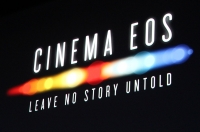 We sat down with Larry Thorpe of Canon at Paramount Studios in Hollywood, Callifornia, where Canon announced their new Cinema EOS C300 and C300PL digital cameras. The new cameras are aimed at giving dedicated movie makers a small and versatile digital cinema camera, improving overall workflow and speeding production.
We sat down with Larry Thorpe of Canon at Paramount Studios in Hollywood, Callifornia, where Canon announced their new Cinema EOS C300 and C300PL digital cameras. The new cameras are aimed at giving dedicated movie makers a small and versatile digital cinema camera, improving overall workflow and speeding production.
Shawn Barnett: As was highlighted in the presentation, the new C300 Cinema EOS camera was developed largely in the response to the movie industry's reaction to the 5D Mark II. But the C300 is noticeably different from that camera.
Larry Thorpe: It's a definitive step from the 5D Mark II, in that this camera was born and raised to be a motion image camera, and no DSLR thoughts in it whatsoever. You can take a still picture at 1920 x 1080 HD frame, and it’ll record on an SDHC card, but it's for motion pictures.
SB: Absolutely for motion pictures.
LT: Yeah. Absolutely.
SB: So how much of this was derived from the prototype camera we saw at Canon Expo?
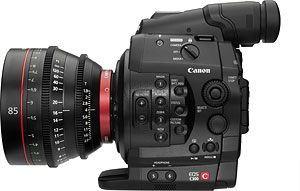 LT: Very little, actually. What you saw at Canon Expo was a 2/3 inch 4K camera, small format, which is very unusual. But it clearly demonstrated that we were working in the vineyards of 4K. We decided to make our entree into motion imaging, one that would let us hit the ground running with a thriving, global business, and at this moment in time, that's HD. 4K's out there, but it's not out there hugely. The Reds and Sonys are doing trojan work, developing it. Workflows are still tough, expensive - but we believe it's coming, and we'll be ready. And, as I say, we've done basic 4K work, but we thought it much more important to try and come out and hit this HD market - which would allow us to get into a certain amount of movie making, a lot of television production worldwide, television commercial production, corporate, business, industrial, military, government. A lot of people want motion imaging with shallow depth of field, and we'll address those… all of those markets, with a primary focus on movie, television, television commercial.
LT: Very little, actually. What you saw at Canon Expo was a 2/3 inch 4K camera, small format, which is very unusual. But it clearly demonstrated that we were working in the vineyards of 4K. We decided to make our entree into motion imaging, one that would let us hit the ground running with a thriving, global business, and at this moment in time, that's HD. 4K's out there, but it's not out there hugely. The Reds and Sonys are doing trojan work, developing it. Workflows are still tough, expensive - but we believe it's coming, and we'll be ready. And, as I say, we've done basic 4K work, but we thought it much more important to try and come out and hit this HD market - which would allow us to get into a certain amount of movie making, a lot of television production worldwide, television commercial production, corporate, business, industrial, military, government. A lot of people want motion imaging with shallow depth of field, and we'll address those… all of those markets, with a primary focus on movie, television, television commercial.
SB: How important is it for those in the movie industry, for archival purposes, to look beyond Full HD?
LT: You would get a variety of opinions there. Some of the studios feel it very important to archive at very high data rates; others feel it depends on the movies -- am I a blockbuster, or a B movie? So, you'd find a variety of answers to that, but there's definitely those who do believe they want the 4K, and they're scanning their films at 4K and above, for that reason.
SB: What impact do you expect the C300 to have on the 5D Mark II sales?
LT: Very little, I think. The 5D Mark II is still largely a DSLR. Yes, it's been used in all these motion picture applications -- not many movies, full length, were shot with 5Ds--there has been a couple, but not many. But it has come in as a B&C camera to give those special shots, extreme shallow depth of field, large frames, and that'll continue. So, in that sense, it will be an adjunct to this camera. We see our new camera going out as the A camera for motion imaging, and a 5D being used where a 5D makes sense, with the large format. Our initial cine prime lenses that we've made that you see down below -- we made those EF, so that they can hang on this new camera, but also hang on a 5D and cover that large format. So we've sort of recognized that the 5D will be a supporting baby brother to this camera.
SB: Will that lens also work on a Rebel, for example?
LT: Yep, it'll work on EF... if it's EF, this lens will work.
SB: You think of the big Canon lenses that are used for television broadcast, and how much of that DNA from those lenses is in these lenses?
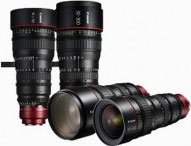 LT: A lot. These lenses, the cine lenses that you're heard about today -- the primes and those zooms, the PL and EF -- are developed by the Broadcast Division... the Optical Department of the Broadcast Division.
LT: A lot. These lenses, the cine lenses that you're heard about today -- the primes and those zooms, the PL and EF -- are developed by the Broadcast Division... the Optical Department of the Broadcast Division.
SB: Wow, that's awesome.
LT: Yeah, same division, same people. The head of it is right down there -- Mr. [Jun] Hosoya, he heads all that up. He's tickled to be into this new business. And what's very interesting, is that the PL and EF, those two zoom lenses you saw; they were born of a new optical platform he developed, because four years ago, he was asked by NHK to develop an 8K lens for UH Super-High Vision -- 16 times the resolution of HD -- and he made them a number of lenses, and had to go back to the basics in optics to make those lenses. But, they learned a lot, and on that platform, they developed these lenses. So, these are very high quality lenses.
SB: If you see the 5D Mark II still being used in video, in what percentage do you see it?
LT: I'm not terribly close to the 5D business. I still see it being used for video, because it's $2,500; this is $20,000. Now, there's a big difference between the video quality of the two cameras, but the 5D has done... it's in movies, so if you take proper precautions, you can get the picture you want.
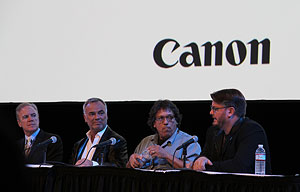
Four directors produced short films to demonstrate the capabilities of the Canon C300. Here they discuss their experiences. Left to right are Sam Nicholson, Richard Crudo, Felix Alcala, and Vincent Laforet.
SB: A lot of the guys that were up there talking on the panel at the press conference said that they really felt freed from some of the limitations of the 5D Mark II.
LT: Well, there were a lot of limitations.
SB: What were the key limitations?
LT: Well, one that you always heard them squawk about was audio -- it was abysmal. You can't get a proper video feed out -- the HDMI has this compressed thing, they want a baseband video out; on this new camera, we give you that as a HD/SDI BNC and on an HDMI Type-A baseband, uncompressed video. So, big, big differences like that. And then the audio on this, we have two channels of full linear PCM audio, 48Khz, 16-bit; all the things that are important to production. Then you come to the controls, and the placement of the controls that are sacred to the operators of these cameras. We had about 150 interviews over the last year and a half with folks here, in New York, and overseas, major filmmakers, talking to them and saying, "We're thinking of making a very compact camera. Help us shape it, and help us put the controls in the right place, and by the way, identify all the controls you'd need," so the camera's very flexible from that point of view.
SB: Am I correct in thinking that actually two people operate the camera typically, it's not just one person?
LT: That's right, well, you have the AC, and the focus puller, and etc.; and that can vary. I mean, if you're doing a handheld, you might elect to do the shoot yourself, but in one of the shots you saw today you'll see a guy running along with them that's watching the focus.
SB: Well, and some of those big lenses were designed so there's room... even though the camera itself is small there's room for more than one person to operate it.
LT: Exactly.
SB: What markets will this open relative to a purely video-only device?
LT: Well, I don't know about opening... The markets that we hope to enter, be accepted, is moviemaking at various tiers -- television production, all forms of it that want shallow depth of field. Sports is going to stay small, 2/3 inch for long depth of field, but for drama, promos, all that sort of stuff, folks like that "movie look"; television commercial, that's a big one. Those three are our primary markets of interest. After that, it'd be other applications -- government, etc.
SB: What does this camera have over, say, Canon's other camcorders -- you've made some fairly high quality camcorders.
LT: One thing, our sensor, and 35mm format. Loved by the film world. That's the biggest distinguishing factor.
SB: Because you can really tell a story with that, that's true.
LT: Yeah.
SB: I think you already touched on this, the ability to pass the recorded image along the SDI connection is obviously new. In what sort of applications will this be helpful?
LT: Well, a lot of people will choose to record -- if they're doing a serious, major movie --they'd like to record an uncompressed signal on an uncompressed recorder so they have all the information, while they parallel record on the cards, and then they'll use those cards for their offline editing. But the master is baseband.
SB: What can you tell about the new Super 35 sensor? What underlying technological differences are there relative to the sensors in 35mm?
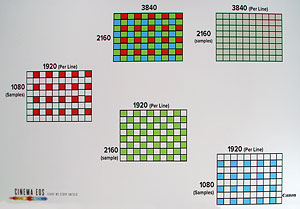 LT: I'll try to give a very quick and simple explanation today, and that is, it's what we call the "Bayer" pattern. So the red, green, blue are coded like all the other cameras that are out there. For all those other cameras, for them to then reconstruct the red, green, blue, as separate videos that they can process, they have to de-Bayer. That's a very complex, algorithmic based process, because what you're trying to do is -- when you see the blue, it's what we call "sparsely sampled," it's got all those empties -- you've got to fill those missing pixels in blue and red and green, and that's done by a very high computational algorithm that's sucking from each of them and doing averaging, and plugging them in. So, it's a reconstruction, and it can't be perfect. The more horsepower you put in, more expense, or if you do it in post and non-realtime, you can make it very good.
LT: I'll try to give a very quick and simple explanation today, and that is, it's what we call the "Bayer" pattern. So the red, green, blue are coded like all the other cameras that are out there. For all those other cameras, for them to then reconstruct the red, green, blue, as separate videos that they can process, they have to de-Bayer. That's a very complex, algorithmic based process, because what you're trying to do is -- when you see the blue, it's what we call "sparsely sampled," it's got all those empties -- you've got to fill those missing pixels in blue and red and green, and that's done by a very high computational algorithm that's sucking from each of them and doing averaging, and plugging them in. So, it's a reconstruction, and it can't be perfect. The more horsepower you put in, more expense, or if you do it in post and non-realtime, you can make it very good.
Those cameras that are out there -- the Reds, the Sonys, Alexas -- they're all doing a very good job. But we said we'll skin the cat another way: We'll make a 4K sensor, but that allows us to in that Bayer pattern -- there will be a full 1,920 x 1,080 blue, a full 1,920 x 1,080 red, and effectively two greens. So, we lift them up by readout, because with a CMOS sensor, you're able to readout the pixel if your architecture's correct; so we're able to identify the blues, pull them out, simultaneously pull out the red, and simultaneously pull out the two greens. They come out, out of our sensor comes four wires with four signals on them; then we add the two greens to make a "super-green," and we come out of the sensor red, green, blue -- 4, 4, 4 -- and no contamination of reconstruction. They're absolutely pure, perfect.
 SB: Now, you mentioned... your graphic showed a lighter green and a darker green. Is that because they're different filters on the greens?
SB: Now, you mentioned... your graphic showed a lighter green and a darker green. Is that because they're different filters on the greens?
LT: No, that was just to try and let you visually see that strange, quincunx green structure is actually, effectively two 1,920's laid on top of one another, but offset by half a pixel. Then a half-pixel offset horizontally and vertically is very powerful, because when you add, the alias and sidebands cancel, and you end up with a green that has no aliasing. That's huge -- that makes us... we have the cleanest HD video in this camera. It's brilliant.
SB: Why did you choose to go with CompactFlash?
LT: Well, that was born because CompactFlash was in our DSLRs for some years, and it just made an awful lot of sense. We know those cards very well, we put them in our little camcorder, the XF series camcorder as well. They're ubiquitous, they're available, they're obviously lower cost than some of the other more sophisticated cards. So it's just turned out to be a very good card, but the availability was a big importance, and the modest price -- it's not cheap, but it's cheaper than some others.
SB: And the dual cards are designed to write at the same time, can you also just have them flow one to the other?
LT: Yes, you can select to write at the same time so you'll have your back-up, or you can do sequential recording with the automatic transfer, and you can hotswap, and you know, you've got...
SB: Is there anything special about the cards, that you have to have some spec?
LT: You have to... Yes, you have to... there are grades of these cards, and you can pretty well... your basic recording, if you're doing a 60i, you can record on pretty well any of these CF cards -- if you get into the fast motion, slow-mo, where you're going up to the higher frame-rates and things like that, you need to be careful. And if you're going into the variable motion, and we have a chart that's published that says, "These are the manufacturers," and whatever they call them, Grade I, II, III, stay with these and you're OK.
SB: Do you see any areas in which technology developed for these new cameras may transfer into your SLR product line?
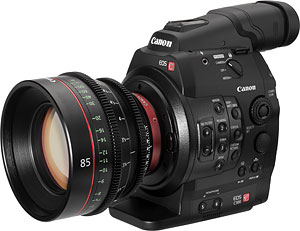 LT: There's always possibilities of that, and there's now more cooperation between the engineers and what we used to say... the video who did the XF camcorders and the EOS; they lived in a separate world. This project brought some of them together, and Mr. [Masaya] Maeda, he was banging heads to make sure that as we go forward, you're going to see more and more of that, so there's going to be a lot of cross-fertilization. The DSLR folks, when they design a sensor, they've got criteria -- you know, they're looking at ISOs of 200,000 -- and we don't worry about that sort of thing in the motion side. But, you know, great technologies come from both, and this new sensor was developed by the group that normally had two separate groups, doing a little 1/3 inch and the others doing the EOS, and they came together with some great ideas, and came up with this, what I think is a brilliant architecture.
LT: There's always possibilities of that, and there's now more cooperation between the engineers and what we used to say... the video who did the XF camcorders and the EOS; they lived in a separate world. This project brought some of them together, and Mr. [Masaya] Maeda, he was banging heads to make sure that as we go forward, you're going to see more and more of that, so there's going to be a lot of cross-fertilization. The DSLR folks, when they design a sensor, they've got criteria -- you know, they're looking at ISOs of 200,000 -- and we don't worry about that sort of thing in the motion side. But, you know, great technologies come from both, and this new sensor was developed by the group that normally had two separate groups, doing a little 1/3 inch and the others doing the EOS, and they came together with some great ideas, and came up with this, what I think is a brilliant architecture.
SB: To what extent will these new models be available through traditional Canon sales channels?
LT: What we're doing -- and this is still in the heavy planning phase -- we will have a select number of dealers, and a select number of rental houses. It'll be a small number, and we're picking those who will meet certain criteria that we have -- one of which is, that they be in the cine-business; they know the constituency and that they know how to support and service, backed by us. We will be providing them with tremendous support. So we're going to market with rental houses, dealers, and then we have a Direct Sales force; they will go to certain customers. For example, a lot of customers that we - in my formal work at Canon, I man the broadcast division -- we would sell direct to the networks, for example, the truck operators. And they still like... a lot of them still like the small format, 2/3 inch; but broadcasters, like Turner Broadcasting, CBS Networks, CBS Television City who do high-end drama -- we'll probably sell to them direct, unless they have an established relationship with a particular dealer. Or unless they want to rent instead of buying, but if they want to buy -- so we'll have the dealer channel, the direct, and rental.
SB: And direct would be direct from Canon?
LT: Direct from Canon -- our salespeople. We have twenty... In our new organization that we've setup to support this professional world, we have twenty three direct salesmen across five sales regions across the United States, and we have five Canon headquarters, each with a service center. So we're going to be able to service and support.
SB: So an independent filmmaker who's been using, say, a 5D, and cut their teeth, say, with that or even another DSLR...
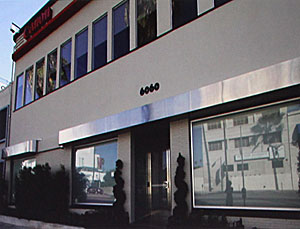
Canon announced their Hollywood professional Technology and Support Center, housed in part of an old Columbia Pictures Studios building. Canon says they will use the facility for market research, product demonstrations, seminars, repairs and testing.
LT: We would steer them to a dealer. We wouldn't have our salespeople work on individual people like that. We go to organizations and entities that want to buy direct, have been buying direct, like networks and big broadcasters.
SB: You also mentioned the support building that you have here in Hollywood, so the question becomes, is that support going to start branching out into other countries -- say, India, and...?
LT: The answer to that is yes, that will be handled -- we have marketing companies, Canon Europe, Canon Asia -- and they're all here, their chief executives are here, they're part of this, and they are setting up their plans, their services, their centers. It's a worldwide Canon movement, but handled individually in those markets.
SB: Even though you've had camcorders that were probably being used in production, would you say then, this is a new level of support that Canon hasn't had before for video?
LT: It's a new level of support, yes, because we're recognizing that the movie industry is very important. It's high dollars, equipment can't go down -- it has to be supported, it has to be that instant access to support.
SB: Does the camera come with support, or ...?
LT: We'd be selling support programs. We have support programs for rental houses, for dealers, and for direct customers.
SB: And will there be support for the 5D Mark II at the same centers?
LT: Well, we have an incredible support system for the 5D right now -- incredible! You know, our CBI center down in Virginia, hundreds of people there - it's a huge organization. It does a brilliant job...
SB: Canon announced two high-end PL-mount lenses last April; the FK14.5-60 and FK30-300, and you've announced the other ones tonight. Now that Canon has PL-mount bodies of their own to use with these lenses, can we expect to see accelerated development for more new PL-mount optics?
LT: Yes. What we're going to do from here on -- first, let's back to NAB, we introduced, and my broadcast division brought them in, two PL-mount lenses -- and those same lenses are, for this camera; the PL... obviously, will hang on the PL version of this camera, those same lenses, we're putting an EF back on them, so they'll hang on the EF version. So the two constituencies, that EF world globally, and the PL world, whatever they want -- these guys own lots of EF lenses, they'd like to buy these cameras so they can start using their EF lenses, and then move up to a cine lens with an EF back. We have that. So, we've got two so far. We will be introducing two more zooms next year -- lighter, lower cost...
SB: On the PL mount?
LT: On the PL and the EF. So our strategy going forward is to keep covering PL and EF, in parallel. Very unusual strategy, but recognizing two huge worlds out there. On a worldwide basis, PL is huge; it's the de facto standard. Panavision have their own, but PL is the de facto standard. And you've got guys out there who own PL lenses -- they might have them from Zeiss, Fujinon, Angenieux, etc. -- and they like our camera, they can buy our camera and use their lens on our camera, and we hope they would subsequently buy our zoom lens, PL. And then this other constituency out here, which is largely still-imaging, but we've got 70 million of those lenses out there, worldwide; so some tiny percentage of those guys are aspiring to get into motion-imaging; this way, they can start by using their existing lenses, buy this camera, and later buy an EF cine lens.
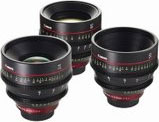 We've brought out three cine primes, EF only, initially; the only reason for that is we're so stretched. We gave the bias to EF because that EF lens will hang on our new camera, but because it's an EF lens, it can also hang upon a 5D and cover the full frame, because EF optics were designed for full frame, so that's a nice little dexterity that we're offering.
We've brought out three cine primes, EF only, initially; the only reason for that is we're so stretched. We gave the bias to EF because that EF lens will hang on our new camera, but because it's an EF lens, it can also hang upon a 5D and cover the full frame, because EF optics were designed for full frame, so that's a nice little dexterity that we're offering.
SB: So that's the advantage of choosing the EF body, is the compatibility with your existing lenses, and perhaps your existing bodies. Is there...
LT: Exactly. Because we do see the 5D being a B camera to this camera, for certain shots in their movie.
SB: So is there a similar advantage, or a different advantage, to choosing PL?
LT: The big advantage of PL is the customer is able to go anywhere in the world and get true cine lenses, and they don't have to be ours. They can go to a rental house and get a Zeiss.
SB: A lens that they need for a particular shot.
LT: A lens that they need, or if there's a prime range that we don't have, they can mix and match - they're all on the standard of PL.
SB: Can one body be converted to another type if necessary?
LT: No. It's possible that a little cottage industry will develop... the kind that always springs up to make adapters, but we won't. We decided... we did discuss a lot, "Should we make one camera with EF adapters you can take on and off, and PL?" And we decided, no, that gets into that whole tolerance thing, the shimming issue and the 52mm that's sacred. And we said, "No, there's two big constituencies, let's make two versions." I think it was a great decision.
SB: And the pricing is the same on both?
LT: Haven't finally decided that. There's a possibility we'll make a small differential, but we're still going through a lot of discussions on pricing. About $20,000 it'll be, that's pretty close.
SB: Canon's PL mount lenses are advertised as performing in accordance with the emerging 4K production image format standards. What does this actually mean in terms of imaging?
LT: Aha! I was fully expecting that question. Let me see, I guess I can do it here. You got a bit of paper? The way I explain it is...
SB: Oh, wait, you know what? You can use my envelope, cause I'll be bringing home... There you go.
LT: Alright. HD is 1,920 by 1,080. 2K as standardized by SMPTE is a small variation on that, it's a little higher than that -- it's 2,048 still by 1,080; that's 2K. 4K is 4,096 by 2,160 -- that's an SMPTE standard. So the way I explain is... if today, this world is largely 2/3 inch, the Nyquist for this is 1,080 TV lines-per-picture-height. This is your HD bandpass... it's your 30 Mhz, your 1,920 fits in there and vertically your 1,080 fits there, so this is your useful passband. Now, a really, really good lens for HD would have maybe an MTF that's 60-70% at band edge. After that, it doesn't matter, because this is all you're interested in, and you want to keep this as high as possible. So that's HD, and approximately 2K. A 4K, it's Nyquist is exactly twice that, because it's 2,160 and it's twice... 2,048; it's out at 2,160 TVL per picture height. And I would say one possibility of a definition of a 4K lens, if that's a 2K or HD lens is... if that's 70 or 60, let's make a lens that will do that -- have the 70 and 60. You can see it's a very different lens to this. The advantage of this 4K lens is this is much higher in this pass band than this is, so if you put this lens on an HD camera, you get a very sharp HD picture. We did make our cine zooms to this sort of spec.
SB: OK. So, to the 4K?
LT: To the 4K. That's the simple explanation.
SB: That's for the EF and PL?
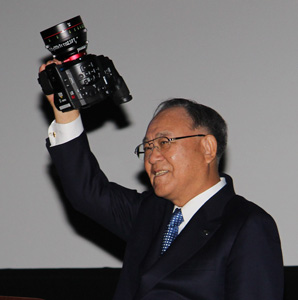
Canon Chairman and CEO Fujio Mitarai holds up the Cinema EOS C300 for the first time for the Hollywood audience.
LT: Yes. After that, you'll have to bring in other things, too. When you go to 4K, you've got a lot more pixels, a lot more resolution -- you've got to watch your chromatic aberration. That which might have been acceptable at HD needs to be much lower in a 4K lens, we did that. We made it lower, it's much tighter. And then you have to also watch the fall-off -- this is picture center; the minute you move from picture-center in any lens, your resolution falls off, that's fundamental optics. But you try to control the rate of that fall-off, and hold her up, so the edges are still very sharp. That's in our 4K lens, we've been able to hold her up. And then the last thing is focus breathing; on our lens, the spec is +/- 1% focus breathing. There's a lot of things that go into making a really good 4K lens.
SB: So all of these lenses are spec'd for 4K, then?
LT: Yes, all of the cine lenses, the primes and the zooms.
SB: Not the regular EF.
LT: Not the regular EF. Though, regular EF, actually, some of them... they're quite variable, some of them have 4K resolution - probably not as high as this, but they get out there, and they'll give you a 4K picture that's pretty decent.
SB: Okay, because they're designed to address even higher resolution, really.
LT: Exactly.
SB: Given the significantly lower cost of these new bodies, relative to some of the competition, might we also expect to see some somewhat less expensive PL lenses... PL lens models somewhere down the road.
LT: Yes. In the fourth quarter of next year, we'll have two new zooms, and then in the beginning of 2013, we will have a few new primes to add to the three primes. So that's sort of the rollout, and those new zooms will be 4K, but they'll be lower cost, and they'd probably be not top-notch 4K, but still very good 4K, genuine 4K, but some relaxation of specs, that's all not defined yet... but the cost would be lower and they'd be lighter so you could use them in steadicams and things like that.
SB: So right now, the budget market would probably use EF mount lenses? Currently, they'd just default to that?
LT: Yes.
SB: The interesting thing in the industry is that, and I was informed of this by a Canon person, is that for years, Sony and Canon have had a relationship in the broadcast industry in particular, where Sony essentially made much of the electronics and cameras behind the Canon lenses, and they used Canon optics in the product. It seems that this move... this camera effectively changes that relationship.
LT: It depends. It could, but we hope it doesn't. The word "co-opetition" is very much a paradigm of today. For years, Sony's made cameras, and we made lenses -- broadcast lenses, field lenses, portable lenses, ENG lenses; thriving business with Sony, Panasonic, [Thomson] Grass Valley, and we still do -- we still do. Then we and Sony started making these small camcorders, and remember -- Sony, Sharp, JVC and Canon, we made that consortium that created the HDV standard; we agreed to agree on a format, and then go out with our product and compete. So we've been competing with Sony and Panasonic at that low-end, JVC, at the low end. Now, with this, you can argue we're moving up a notch; might that bother Sony? Possibly; I don't know, I don't know -- we have to see. What I would say to my... and I've worked for Sony for 22 years, I'd say, "Look, we can compete but still cooperate. You need our lenses for... you don't make broadcast lenses, we do. Why wouldn't you..." and those customers that love Canon lenses. Our hands of friendship will be held out, but I don't know -- I honestly don't know, I haven't heard anything yet. But I'd imagine some people at Sony would say, "What's going on there? Have we've got a new competitor?" Yes, we are, we are.
But you know, Sony's up there running F65 and F35, so we're down here at $20,000; these are upwards of $60... 70... 80,000, we're not competing...
SB: You're competing at the F3 level.
LT: F3 level, yeah, yeah.
SB: Interesting.
LT: But we certainly hope that the cooperation continues.
SB: Last question, is Canon going to come out with Vincent Laforet's camera helicopter as an official accessory? [Referring to one of Laforet's various tools shown in Canon's "Making of" video.]
LT: Wasn't that a joy? I loved that, I loved it.
SB: Alright, thanks very much!
LT: Thank you very much.